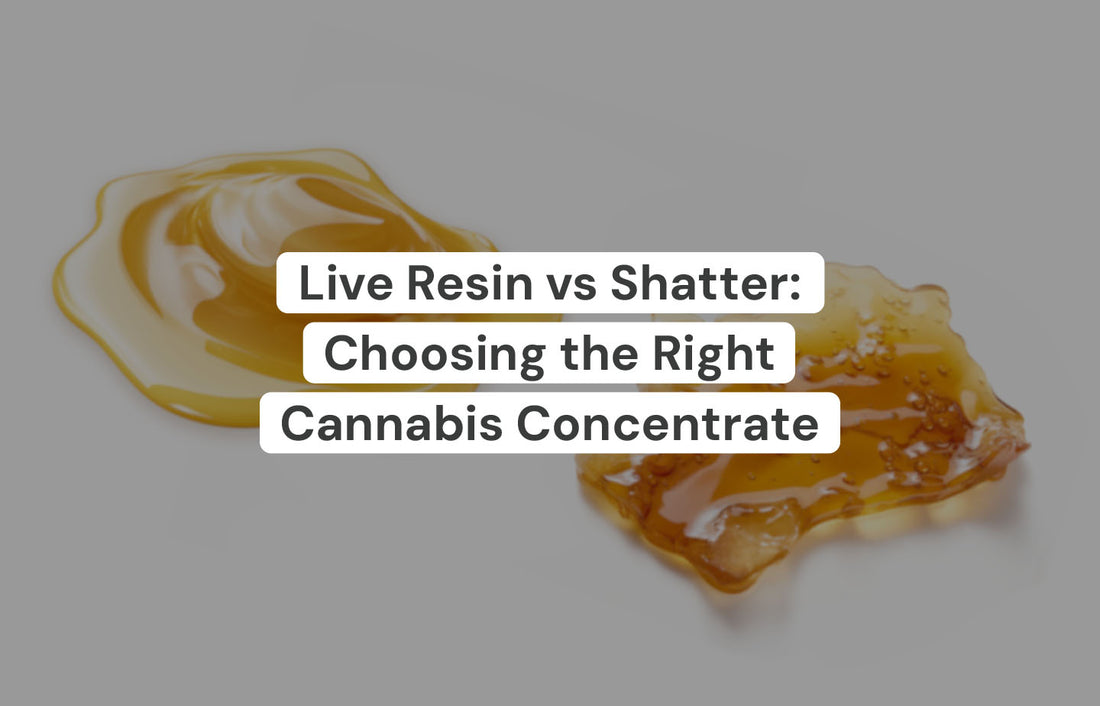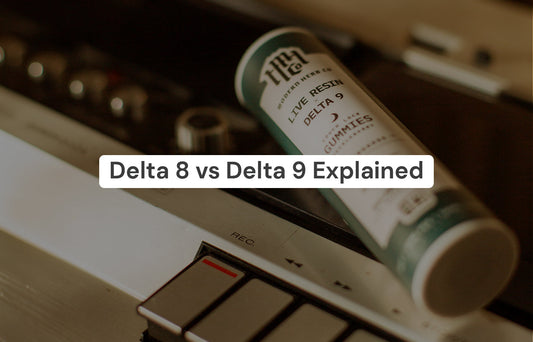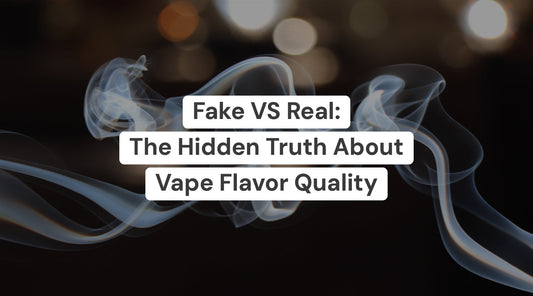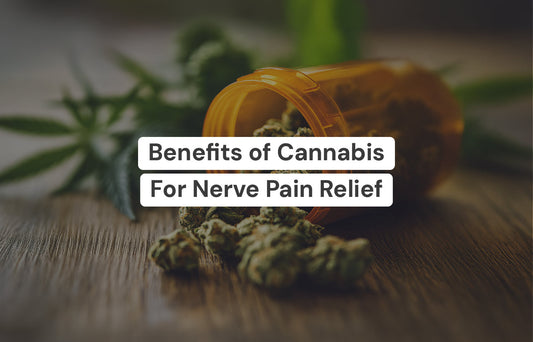
Live Resin vs. Shatter: Choosing the Right Cannabis Concentrate
Choosing the right cannabis concentrate can feel overwhelming due to the myriad choices available today. Options range from live resin, shatter, and wax to pure THC distillate.
Live resin and shatter stand out as two of the most popular and sought-after concentrates by cannabis enthusiasts. However, each offers a distinct and intense experience and caters to different preferences.
While they are two different products, they have some similarities, making choosing one even more difficult. It's essential that you understand what each concentrate offers and how they are made to make the best choice.
In this article, we take a look at live resin vs. shatter, discussing their appearance, potency, extraction methods, and even ideal consumption methods to help you make an informed choice that will align with your preferences and desired effects.
Table of content
WHAT IS SHATTER?
Shatter is a cannabis concentrate known for its glass-like and brittle consistency. Like most concentrates, shatter is made from dried and cured cannabis plant material, which means it may lack some terpenes present in the live plant.
Shatter is one of the many forms of butane hash oil. BHO, or butane hash oil in full, refers to cannabis concentrates produced through a process that involves butane to extract trichomes from plant material. Other forms of BHO are wax, crumble, budder, and live resin.
Shatter typically has a golden to amber color; depending on the extraction process, it may appear semi-translucent or transparent. However, how clear the shatter is does not indicate that it's of higher quality or purity than the translucent types.
True to its name, shatter tends to 'shatter' when handled, often breaking into smaller, shard-like bits, just like glass would if dropped. This characteristic is an advantage to some as it makes it easier to dose, while others believe its tendency to shatter makes it harder to handle.
This concentrate contains all the compounds of cannabis, including THC, CBD, CBG, CBC, CBN, and others, but it has fewer terpenes compared to live resin as it's made from already dried and cured cannabis material. Still, some producers may reintroduce terpenes during the final stages of shatter production to enhance the taste and benefits of the product.
WHAT IS LIVE RESIN?
Live resin is a premium and ultra-potent cannabis concentrate known for its rich terpene profile that makes it more flavorful than other products. But what makes live resin goods stand out?
What makes live resin unique is the specialized extraction process that ensures many terpenes in the living cannabis plant are preserved and made into the final product.
Unlike other cannabis concentrates, such as shatter, whose extraction begins with dried and cured cannabis material, live resin is made from plant material that is flash-frozen immediately after harvesting.
By rapidly freezing the harvested cannabis, delicate and volatile terpenes that would otherwise be lost during drying and curing processes are retained. These contribute to its exceptional aroma and taste.
Live resin is still considered a BHO as its extraction process typically involves blasting the frozen material with a solvent such as propane or butane to separate the trichomes. This process is performed in a highly controlled environment to preserve the plant's natural essence.
As such, the solvents are purged in a vacuum oven to avoid applying high temperatures that could damage or vaporize terpenes.
WHAT ARE THE MAJOR DIFFERENCES BETWEEN LIVE RESIN VS. SHATTER?
Before we get into the differences between live resin and shatter, here are some similarities. First, both are BHO concentrates extracted using a butane and propane blend as the solvent. Both are super potent, can be consumed using the same methods, and have a relatively long shelf life when stored correctly in a cool, dark, and dry place.
Here's a breakdown of shatter vs. live resin differences to help you make an informed choice:
TEXTURE AND APPEARANCE
The texture and appearance are the most apparent differences between the shatter and live resin products. As the name suggests, shatter has a brittle, glass-like texture and tends to break when handled. It is golden or amber and appears translucent when hit with light.
On the other hand, live resin has a viscous texture that ranges from sap-like to waxy, depending on the production process. The high concentration of terpenes in live resin makes some products have a runny consistency.
Since heat is not used in the process used to make live resin, it's challenging to get it to a brittle form like shatter. This makes live resin shatter very rare.
EXTRACTION METHOD
Since both are butane hash oil concentrates, there are similarities in how they are made. However, the starting point is one of their most key differences.
Making live resin starts right at the farm when the still-living cannabis buds are harvested and flash-frozen using liquid nitrogen or dry ice. The frozen cannabis material is then blasted with propane and butane blend to extract the cannabinoids and terpenes.
Butane, propane, or any other solvents are then purged using a vacuum oven to avoid using high temperatures that may denature precious terpenes.
Shatter production begins with dried and cured flowers. Producers then use solvents such as butane to extract the cannabinoids from the plant material. The solvents are then purged using heat in a vacuum oven.
FLAVOR AND SCENT
Here's where live resin truly shines. As mentioned, the live resin process aims to preserve as many of the delicate and volatile terpenes that give marijuana cultivars their distinct flavor and aroma profiles.
The extra terpenes' impact cannot be dismissed. Live resin has a more flavorful and aromatic profile than other cannabis concentrates.
Shatter has a low terpene profile as it undergoes several purification and filtration processes to achieve the thin glass-like texture. Solvents used during shatter production are purged using heat, destroying some more delicate terpenes.
But the main reason shatter isn't as flavorful as live resin is that the process starts with dried and cured cannabis. The drying and curing destroy most volatile terpenes. These terpenes are preserved in live resin production as the cannabis is flash-frozen immediately after it's harvested.
As such, live resin flavor and aroma is more pronounced, representing a specific cultivar's true taste and scent.
POTENCY
Both are highly potent concentrates. However, live resin has a richer cannabinoid and terpene content that contributes to the overall effects. The full plant profile leads to increased potency and supports the entourage effect for a balanced elevation.
Shatter is also very potent. However, the live resin vs. shatter cannabinoid levels depend on the cultivars they are extracted from.
EFFECTS
Live resin contains slightly more cannabinoid content than shatter and has a robust terpene profile contributing to the effects. Terpenes have individual effects and work with cannabinoids to shape the overall experience through the entourage effect.
The entourage effect is a proposed mechanism through which cannabis compounds, including terpenes and cannabinoids, work synergistically to modulate or provide more intense and unique effects.
The extra terpenes in live resin may enhance the overall experience by intensifying/balancing the effects of THC and CBD or by providing additional effects.
HOW IS LIVE RESIN MADE?
The key distinguishing factor when comparing live resin to other butane hash oil concentrates is how materials are prepared.
The first step to making live resin is to freeze the harvested plants. Wondering why? Deep freezing the freshly harvested cannabis maintains the true essence of the live plant. This means all the terpenes, especially the delicate ones, are not destroyed by drying, oxidation, and heat.
Producers use liquid nitrogen or dry ice to freeze the plant material. The cannabis is taken to the extraction plant, where the extraction begins as soon as it's removed from the freezer.
The second step is to prepare the solvent. Most producers use a blend of propane and butane. The solvent blend is chilled to lock out water-soluble plant compounds. The biomass and solvent are then mixed in a commercial-grade hydrocarbon extractor.
The solvent dissolves the trichomes, and the resulting mixture is transferred to a collection tank. Here, it is heated at a low temperature to remove the solvents. The low-temperature solvent purge is essential as you don't want to burn off the terpenes that you have been so carefully preserving. This means that this step will take longer than most other extractions.
The solvent vapors are extracted from the collection tank using a compressor, condensed, and returned to the solvent tank.
Any residual solvent is purged using a vacuum oven. A vacuum oven helps burn off residual solvents by changing the chamber’s atmospheric pressure. The extract that you collect from this process is called live resin. It can be further processed to make other live resin products, including pull & snap, waxes, sauce, and sugar.
HOW TO MAKE SHATTER?
Shatter is more straightforward to make than live resin. Unlike in live resin, the starting material is usually dried and cured.
Producers start by preparing a blend of propane and butane to make a solvent. Low temperatures are maintained, though not as strictly as in live resin.
The plant material is blasted with the solvent blend to pull off trichomes and form terpene and cannabinoid-rich sludge. The mixture is poured carefully from the extractor to avoid agitating the solution. If the solution is agitated, it can turn into sugar or wax.
The extract is poured into a vacuum oven tray lined with parchment paper that helps form the thin, glass-like consistency. The solvent is purged at low heat. After all the solvent is purged, the extract cools down, forming the thin glass-like slabs known as shatter.
HOW TO CONSUME LIVE RESIN VS. SHATTER CONCENTRATES?
Both shatter and live resin can be consumed in a variety of ways, from dabbing, smoking, and vaporizing to edibles. At The Hemp Collect, we use live resin in our disposable vape pens, vape carts, edibles, and dabs to ensure superior flavor, aroma, and overall experience.
DABBING
Dabbing is the most popular way of live resin consumption method. To dab concentrates, you will need high-quality live resin products such as this Anytime Delta 8 Sugar Dab available at The Hemp Collect. For this, you will need a dab rig, a source of heat, a dab tool, and premium live resin or shatter.
Set up the dab rig and heat the nail until the desired temperatures are achieved. Let the nail cool down for about a half minute. If it gets too hot, the terpenes may be destroyed and make the hit not as flavorful. On the other hand, if the nail is too cool, the dabs may not vaporize on contact.
Using the dab tool, scoop up some live resin and place it on the hot nail. The live resin will be immediately vaporized, so be prepared to inhale the vapor from the mouthpiece.
VAPORIZE LIVE RESIN
Yes, you can vaporize concentrates. You will need a disposable pen or a live resin cartridge like this Delta 8 CBD Live Resin Knockout distillate. If you are using a disposable pen such as this Live Resin HHC Daytrip Disposable, all you have to do is turn it on using the button or inhaling, depending on your device type.
If you have a live resin cartridge, attach it to a compatible battery and turn it on. if the temperature ranges are selectable, set it to the lowest setting to enjoy the most flavourful hits.
SMOKE LIVE RESIN
Not a fan of vaping? No problem. We have premium Delta 8 live resin moonrocks just for you. These moonrocks are hand-rolled and heavily covered with kief and delta 8 distillate for an ultrapotent experience. You can also smoke live resin by adding it to the rolled flower in a joint to give it some extra kick.
If you are not a fan of inhalation methods, we have some potent live resin edibles, including live resin gummies, soft gels, and tinctures. Edibles take longer to kick in than dabs; however, the effects last longer.
Start with a small dose of edibles and wait for up to 2 hours before adding more to avoid overdosing.
FINAL THOUGHTS: WHICH IS THE BEST CONCENTRATE, LIVE RESIN VS. SHATTER?
It's not easy to choose a cannabis concentrate for the first time, especially when faced with two good choices, such as live resin vs. shatter. However, there must be one with an edge over the other.
Live resin is overall the better concentrate. It is more flavorful and potent and provides an overall better experience than shatter because of its extra terpenes. Since 'live' plants are used to make it, live resin offers the full benefits and effects of cannabis.
If you are looking for premium live resin products, check out our extensive selection of edibles, dabs, vapes, and flowers at The Hemp Collect. Our products are formulated by combining plant alchemy and science to provide you with the best-in-class live resin experience.
Our products are classified into three: DAYTRIP for a powerful boost during the day, ANYTIME for a balanced, mild effect perfect for any time, and KNOCKOUT for unwinding in the evenings. All products are made using American-grown hemp and lab-tested to ensure quality, safety, and effectiveness.

About Ashley Dellinger
Ashley Dellinger is a trailblazer in the cannabis and hemp sectors, serving as the Director of Innovation at The Hemp Collect. With a keen visionary mindset, she not only propels advancements in these industries but also showcases her versatility as a seasoned professional writer based in Oregon. As a collaborative force, Ashley works alongside leading brands, processors, and retailers to elevate industry standards. Ashley Dellinger's work not only sets new benchmarks but also inspires others to pursue excellence. For a closer look into her insights and experiences, connect with Ashley on LinkedIn, Instagram, and Facebook.


















